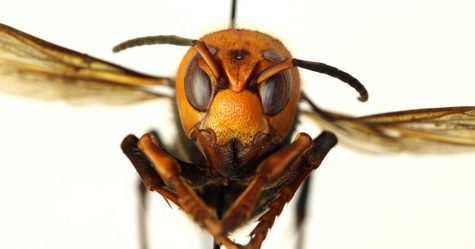“Murder Hornet” spotted in the United States
The arrival of the invasive Asian giant hornet poses a serious threat to the bee population
May 11, 2020
In December 2019, the Asian giant hornet, more popularly known as the “Murder Hornet,” was spotted near the United States-Canadian border. Since then, there have been numerous reports of hornets in areas surrounding Portland, Oregon and the Pacific Northwest.

The invasive hornet species caused an online frenzy once pictures of the insect were released, prompting fears of a murderous hornet population. Growing up to two inches in length and reaching a wingspan of up to three inches, the Asian giant hornet (Vespa mandarinia) has stingers which reach up to a quarter inch in length.
Entomologists assure that these dangerous insects don’t pose a great threat to humans, but can be serious trouble for the current honeybee population.
With an extremely potent venom, honey bees are defenseless against the hornet.
The honeybee contributes an estimated $15 billion each year to the U.S. economy through their help during pollination. However, the Asian giant hornet preys on these bees, killing off hives and occupying them for themselves.
In the midst of a global pandemic, the introduction of the Asian giant hornet to the United States caused a panic among worried citizens.
“2020 has been full of chaos. Just as I thought the coronavirus was letting up, I heard about the murder hornets—the world may very well be coming to an end,” sophomore Tyler Jensen said.
With their life-cycle beginning in April, the hornets spend the spring building up their colonies and growing in large numbers. In the summer, swarms of these hornets ambush beehives in groups during the “slaughter phase.” The hornets then begin the “occupation phase,” where they take over the beehive for several weeks, feeding on larvae.
Known to kill around 50 people in Japan each year, these insects have the ability to inflict serious damage when provoked, with sting survivors describing excruciating pains.
To control the spread of the invasive species, the Washington State Department of Agriculture, with the help of Japanese scientists, have created a detailed set of instructions for residents to build traps at home.
The Department of Agriculture in Washington State will continue setting traps of rice wine and orange juice, methods which have proven successful in Korea and Japan, hoping to locate the nest and take it down by this summer.
Please help share this request from our entomologists:
As always, you can learn more at https://t.co/o8g9ZHvSAd.#AsianGiantHornet #MurderHornet #MurderHornets #InvasiveSpecies pic.twitter.com/kuekAHztPN
— WA St Dept of Agr (@WSDAgov) May 7, 2020

